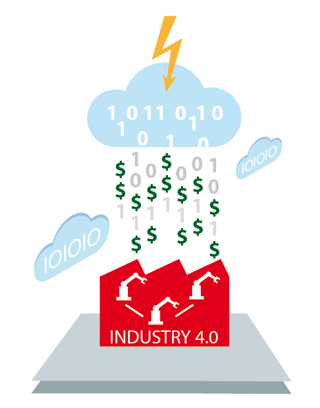Can Industry 4.0 Generate Revenue Growth?
Nick Ostdick - September 19, 2017

 One of the greatest challenges manufacturing companies face in today’s global, competitive landscape is generating and sustaining growth of revenue. Because the manufacturing industry is variant-rich and often reliant on complex partner networks spread across the globe, manufacturing companies often operate in a ‘lean and mean’ context where profits can be fairly small and margins for error in terms of investment and return are razor thin. As a result, companies must deploy a number of concepts, platforms, and campaigns to help bolster revenue, optimize processes, and eliminate instances of waste or redundancy.
One of the greatest challenges manufacturing companies face in today’s global, competitive landscape is generating and sustaining growth of revenue. Because the manufacturing industry is variant-rich and often reliant on complex partner networks spread across the globe, manufacturing companies often operate in a ‘lean and mean’ context where profits can be fairly small and margins for error in terms of investment and return are razor thin. As a result, companies must deploy a number of concepts, platforms, and campaigns to help bolster revenue, optimize processes, and eliminate instances of waste or redundancy.
Enter Industry 4.0 and its ability to help companies refine and streamline processes, increase efficiencies, and enhance the capacity to understand a company’s holistic supply situation. By combining such existing processes or platforms like planning, production, warehousing, and transportation into a digital, integrated, Industry 4.0 is a blueprint for a completely optimized production sequence that resonates across each touch point of the value chain, from the factory floor to the customer’s door.
But even with all these value propositions, can Industry 4.0 actually generate revenue growth? How can these competitive advantages be leveraged into enhanced revenue streams? With these questions in mind, let’s investigate the key aspects of Industry 4.0 and how these elements help companies drive revenue growth.
Increased communication between systems and people
If we think of Industry 4.0 as the evolution of the ‘smart factory,’ then it makes sense how the Internet of Things (IOT) and its reliance on the communication between machines and systems is a core driver in helping companies break down communication and functional silos to increase efficiency and productivity. This means the flow of information about inventory levels, facility capacity, or transportation routes is more consistent and allows for greater segments of the value chain to anticipate potential breakdowns or bottlenecks.The ability of systems and solutions to work in conjunction with each other not only fosters greater productivity and accuracy, but it also provides greater visibility into a company’s overall supply situation. Because Industry 4.0 is in large part about making manufacturers more agile and responsive, the IOT becomes a core driver in creating valuable insight into a company’s demand planning, production, and inventory practices.
Customization
As we alluded to earlier, there’s no such thing as a ‘one-size-fits all’ solution in today’s global supply chain. Planners and managers require individualized solutions to challenges. As such, the customization of products is an increasingly frequent concern for manufacturers in a variant-rich industry with an increasing number of global players and partners. Industry 4.0 - alongside such production principles as additive manufacturing - allow manufacturers to enhance their customization capabilities to address the specific needs of individual customers. The ability to service this level of customization means companies will be more responsive to restraints in production programs and better equipped to weather potential breakdowns or slowdowns in the movement of parts throughout the supply chain. This results in the optimization of planning and production processes, which can significantly reduce waste and help companies maximize their returns on investment (ROI).
Incorporation of cloud technology
The Industry 4.0 supply chain is a data-driven enterprise where the insights gained from this data can be actualized to streamline processes at a variety of touch points across the value chain. As a result, Industry 4.0 demands a powerful platform for storing, sorting, and retrieving massive amounts of detailed data and reporting. Enter cloud technology and its ability to house large volumes of data with multiple access points for enhanced communication and collaboration across company channels. With vast amounts of storage space and the capacity to view and manage data in real-time, the integration of cloud technology is not only a key advantage in reducing the amount of resources and capital manufacturing companies must invest in data storage and management, but it’s also an important component of the future of supply chain management.
Integration of detailed analytics
We discussed in previous entries the utmost importance of data, reporting, and analytics as key drivers in today’s global manufacturing landscape; advanced analytics, with its ability for predictive modeling and planning, it just such a platform in terms of cutting the complexity of complex partner networks and value streams. The ability to optimize production programs and processes is a critical driver for companies in maintaining high levels of productivity and efficiency, and advanced analytics gives planners and managers the data-driven insight to make informed decisions about planning strategies and planned production programs. Industry 4.0 uses advanced analytics to support the push for greater end-to-end (E2E) visibility and increased supply chain agility, both of which are key in avoiding bottlenecks and creating stability across the entire value chain.
LATEST POSTS
- Understand Circular Economy in The Manufacturing Industry
- How Can Industry 4.0 IT Integration Be Achieved Smoothly?
- The Significance of Order Sequencing in Discrete Manufacturing
- How to improve your Supply Chain Management: The Power of Control Towers
- Optimizing Human Resource Scheduling in Manufacturing: A Technological Approach



